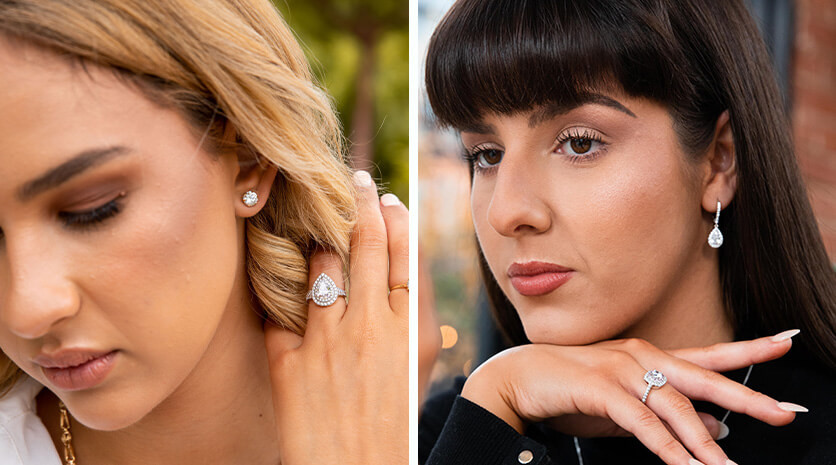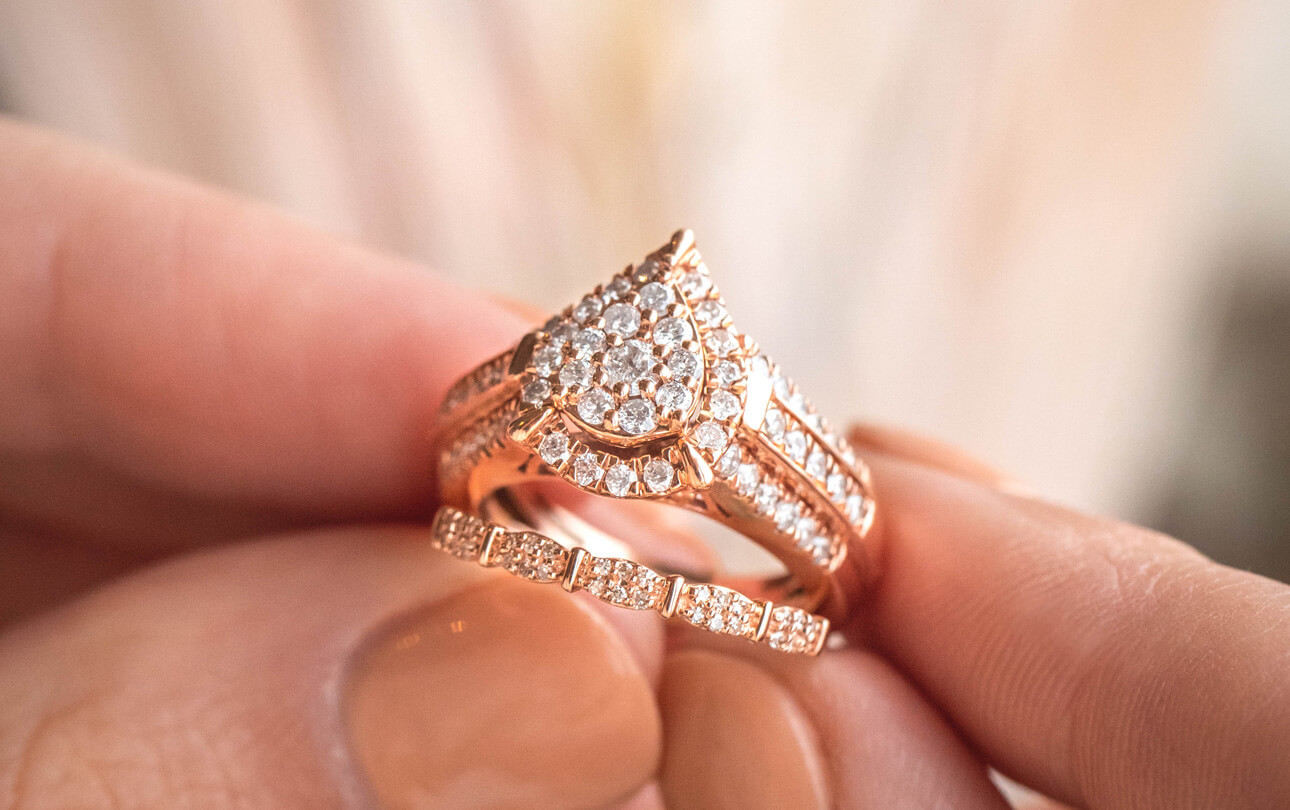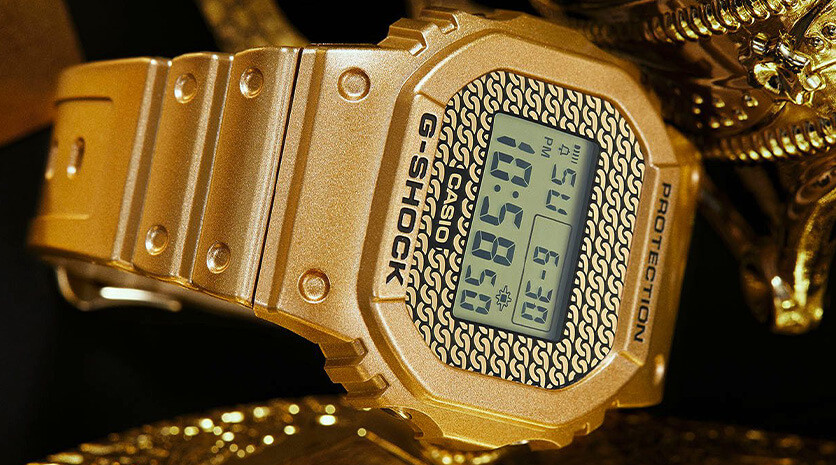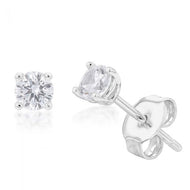There is nothing more frustrating than getting a pair of earrings and discovering that they aren’t suitable for your ears. But unfortunately, that is just the nature of a lot of earrings out there as our lobes are naturally quite sensitive, particularly to certain jewellery and metal types. Having sensitive ears can not only be somewhat costly given that you cannot return most accessories for hygiene reasons, but it also means that many earring styles are off-limits to you. This can cause a great deal of annoyance when shopping for an outfit and jewellery to wear at your next event or when receiving gifts from your loved ones.
According to statistics, around 15 per cent of people that have their ears pierced suffer from sensitive ears, which stops them from being able to wear their favourite pair of hoop earrings, their go-to diamond studs or their fancy pair of drop earrings. Fortunately, there is a way around this and that is hypoallergenic earrings. Hypoallergenic earrings are not a special kind of jewellery made for those with earring allergies, they are merely just earrings that are made from metals and other types of materials that won’t make your ears angry. This means that there is an abundance of different hypoallergenic that will stop you and your ears from feeling discomfort.
But before you rush out to the shops in search of the perfect allergy-friendly accessories, read on as we unpack all that there is to know about hypoallergenic earrings and metal sensitivities.
Overview
- What Is A Metal Allergy
- What Should You Do If You Experience A Reaction?
- Why Is My Jewellery Turning Green?
- What Jewellery Metals Are Hypoallergenic?
- What Jewellery Metals Are Not Hypoallergenic?
What Is A Metal Allergy
A metal allergy is not like getting an allergy to peanuts or wheat, you do not go into anaphylaxis nor do you need an antihistamine to stop the reaction. This is because a metal allergy is not technically an allergy, but rather a skin condition known as contact dermatitis. Contact dermatitis is an adverse reaction that can result in redness, itchiness, rashes, patches of dry skin and even swelling in some cases. It is a condition that occurs in people with all different skin types after objects containing certain materials come in direct contact with the skin. And while it is most commonly associated with earrings due to how sensitive pierced ears can be, it can also occur in other jewellery items such as bracelets, rings and necklaces, as well as other kinds of accessories such as bra straps, belts and watches.
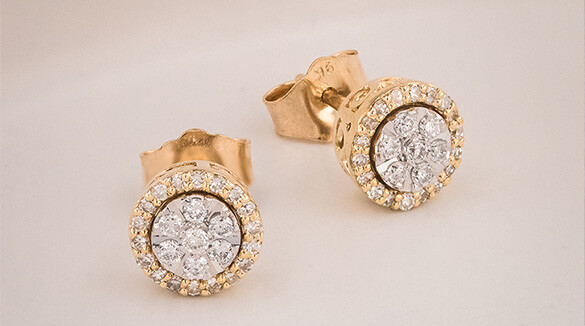
It is a common misconception that it is gold earrings and silver earrings that can cause contact dermatitis, however, it is what is mixed in with these materials that lead to this skin reaction. A large portion of gold and silver jewellery on the market contains metal alloys such as copper, zinc, and nickel because gold and silver on their own are very soft and malleable, not to mention quite expensive. By using these other materials, the jewellery not only becomes more affordable but also a lot heavier and durable. It is the presence of nickel that causes people to suffer from a skin reaction. While no one knows the exact reason some people are sensitive to nickel, the Mayoclinic speculates that it is triggered by an immune response that mistakenly identifies nickel as a harmful substance.
What Should You Do If You Experience A Reaction?
If you are unfortunate enough to suffer from a nickel allergy at some point in your life, it is important to remove the problematic earrings and thoroughly clean the area as soon as possible. As much as you may love wearing your go-to pair of stud earrings or those eye-catching huggies, your comfort is much more important as skin irritations can be quite disruptive.
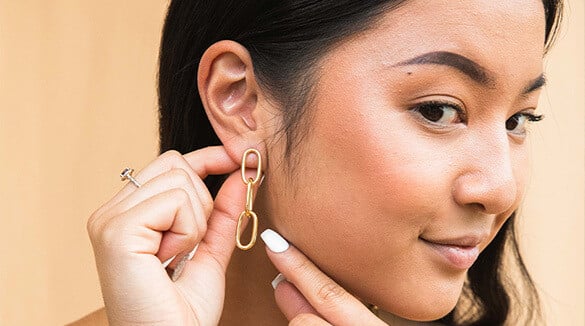
If your symptoms are severe or continue to persist following a reaction, it is important to consult your general practitioner for further support. A health professional will be able to treat your skin and even conduct a spot test to confirm your nickel allergy if necessary. However, nickel allergies are often self-diagnosable and a majority of people will suffer from a relatively mild reaction that usually goes away on its own after a couple of days. There are no treatments for a nickel allergy other than avoiding jewellery that contains the metal. But more on that later…
Why Is My Jewellery Turning Green?
At some point in your life, you’ve probably removed your rings to wash your face or have taken off your earrings to get ready for bed only to discover that your finger or ear where the jewellery once sat has turned a dark green colour. Green skin from wearing jewellery is a chemical reaction known as oxidation. Oxidation occurs when copper, brass or nickel, reacts with elements that come into contact with the skin such as water, perspiration and the natural oils our body produces. It is very similar to the chemical reaction that occurs in some jewellery that causes it to tarnish and discolour.
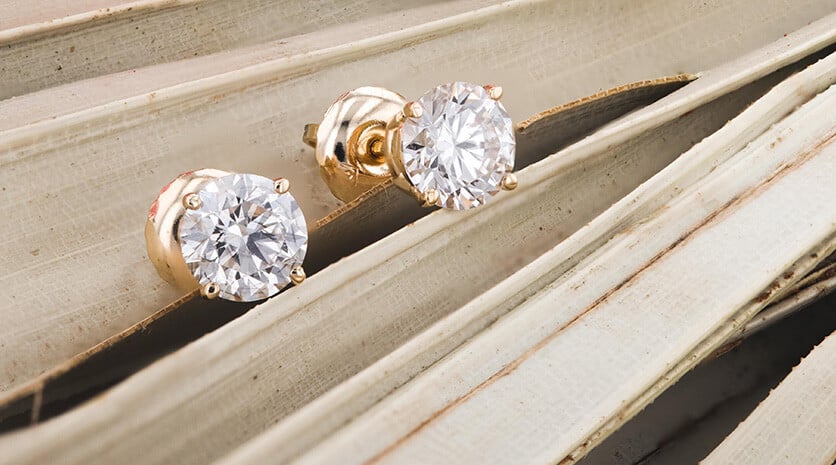
But if you find yourself going green like the Incredible Hulk in a fit of rage, do not be alarmed. The green skin is not a sign of nickel allergy or any allergy for that matter. While it may look unsightly, this skin reaction is painless and won’t cause any skin irritation. It is more common in cheaper jewellery as they tend produced with a higher percentage of metal alloys. However, luckily, unlike nickel allergies the chemical reaction that turns your skin green is preventable. You can prevent oxidation when wearing your pieces by opting for rhodium-plated jewellery, which is jewellery that features a special coating that protects your jewellery from corrosion. You can also avoid green skin by only wearing pieces with a higher percentage of gold or silver and thoroughly cleaning your jewellery to remove any particles after each wear, while also avoiding wearing your jewellery in chlorinated pools, on hot days or in areas where you are prone to sweating as well as when using cleaning products.
What Jewellery Metals Are Hypoallergenic?
While having a nickel allergy may limit your jewellery options to an extent, the good news is that there is an abundance of options out there for hypoallergenic jewellery, namely hypoallergenic earrings. So, when you are on the hunt for your next piece, keep an eye out for earrings containing these metals:
Sterling Silver
Sterling silver jewellery is a go-to for many allergy sufferers because it is relatively affordable, easy to find, versatile and is often regarded as one of the safest options for nickel allergy sufferers. Sterling silver is essentially an alloy that contains 92.5% pure silver while the remaining 7.5% is made up of alloys such as zinc, germanium, silicon, platinum and occasionally nickel. These metal alloys are used to strengthen sterling silver jewellery and to provide it with some extra durability as fine silver on its own is quite soft and malleable.
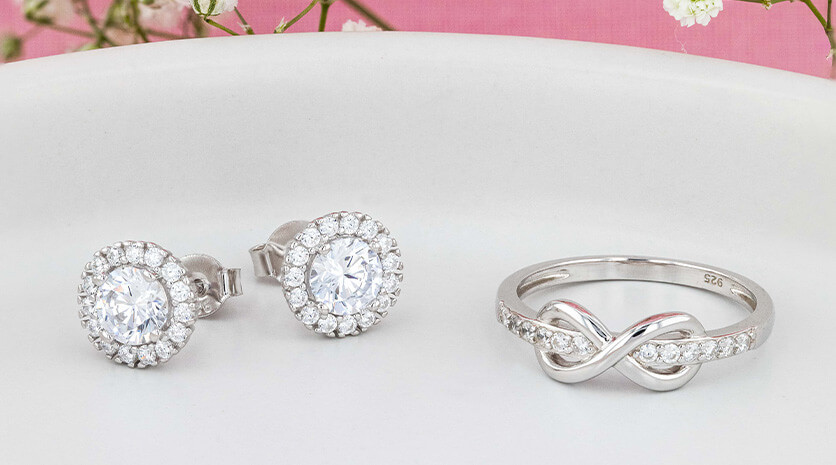
Often referred to as 925 Silver due to the percentage of pure silver present, sterling silver pieces are often identifiable by a watermark with the number 925, which is often stamped on the back. While not all sterling silver earrings are nickel-free, the amount of nickel present is generally small (usually around 7%) and typically won’t cause a reaction. As a result, sterling silver is a very popular choice among those shopping for hypoallergenic earrings.
Gold Filled
Gold-filled jewellery is a type of jewellery that is composed of a solid layer of gold (which is generally around 5% of the item’s total weight) that is physically bonded to a metal alloy such as copper, zinc, and brass or nickel. Gold-filled is a relatively popular choice for everyday yellow gold and rose gold jewellery items such as earrings, pendants, bracelets and chains as it is much more durable than solid gold which is naturally very soft. Unlike sterling silver which has to comply with some pretty universal standards to be considered sterling silver (92.5% pure silver and 7.5 metal alloy), gold-filled jewellery can vary tremendously in terms of the amount of gold it contains.
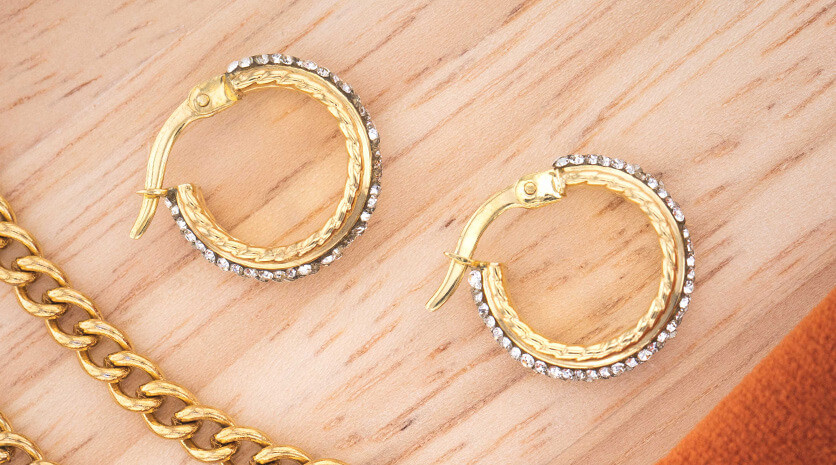
Gold-filled items make up the popular jewellery types 9-carat, 14-carat, 18-carat and 22-carat gold and they help determine how much pure gold is present in present in a particular piece. 9-carat and 14-carat gold are arguably the most popular choice for everyday items because they are much more affordable, they consist of 37.5% and 58.3% of gold respectively. For many shoppers, the most desirable type of filled gold is 18-carat gold as it features around 75.5% of gold because while 22-carat and 24-carat gold may seem very appealing on paper with around 99.5% and 99.9% of pure gold present, they are often considered too soft and delicate for items such as diamond rings and diamond jewellery.
While filled gold can occasionally contain nickel, it is extremely rare. And if a particular gold item does contain nickel, you will still be safe to wear gold-filled earrings as they will generally have a thick layer of gold that works as a barrier between you and the metal alloy. Not to mention, if it's a higher value item like 18-carat gold diamond earrings, the amount of metal alloy is very low.
Stainless Steel
Stainless steel is an incredibly sturdy and durable metal that is used for a wide range of objects including jewellery, cutlery, stainless-steel watches, cookware, kitchen counters, handles and much more. While it is more commonly associated with men’s jewellery, however, it has retained its popularity among all jewellery lovers as it often retains its shine while also being resistant to tarnish and corrosion, unlike silver jewellery that looks remarkably similar to stainless steel. Stainless steel jewellery is often crafted from other alloys including steel, chromium and nickel.
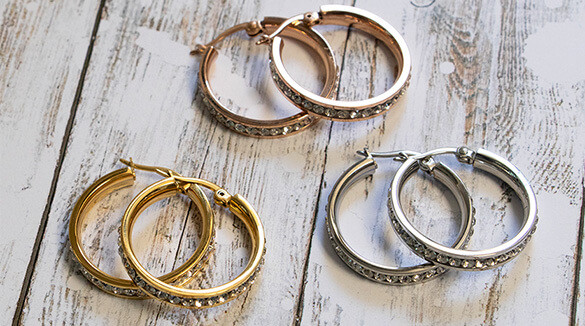
While stainless steel earrings can be safe for those with skin sensitivities, they are not exclusively hypoallergenic-meaning that they are not suitable for people with severe allergies as the nickel content can sometimes be quite high. However, it is important to note that the percentage of alloys in a stainless steel piece can vary. When shopping for stainless steel earrings and other pieces made from the material, keep an eye out for jewellery hallmarked with the number 304 or 316 (surgical steel). Alternatively, opt for something with the label “nickel free”.
Titanium
Titanium is a silvery-grey metal that is very similar to stainless steel in the sense that it is very durable and hardwearing. Commonly used for medical implants and even body jewellery such as belly bars, toe rings, anklets, tongue studs as well as nose studs. Titanium earrings are perhaps the most appropriate for those with sensitivities to nickel as it is not known to contain any of the metal alloy as it is often medical grade meaning that it is often the best choice for avoiding angry lobes.

Titanium jewellery is arguably one of the best choices for hypoallergenic earrings as is one of the only metals that doesn’t rely on nickel as a metal alloy. In fact, professional body piercers will often recommend jewellery that is made from titanium when you first get your piercing as it is super easy on the healing process, which anyone with multiple body piercings will know, can be the source of a lot of discomfort. Titanium is also less likely to cause your piercing from becoming infected.
What Jewellery Metals Are Not Hypoallergenic?
White Gold
White gold jewellery has always been a favourite among jewellery lovers. Given how well it goes with diamonds, there is something about white gold that is so incredibly timeless yet understated. A luxe alternative to silver, white gold jewellery is highly regarded because it doesn’t tarnish like gold and because it has a significantly higher value than the former. White gold’s classic aesthetic, subtly and its ability to pair seamlessly with diamonds is perhaps why it is one of the most widely used metals for engagement rings and wedding rings. Much like other types of gold, white gold is an alloy and is produced by mixing pure gold with silver, palladium or nickel.
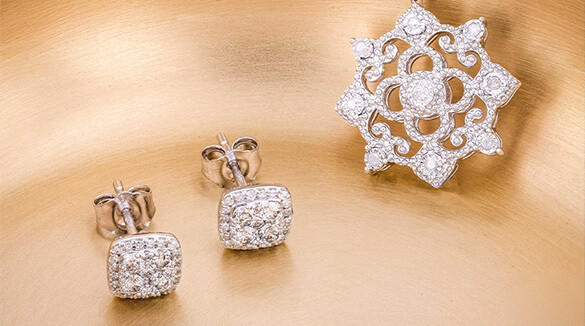
Unfortunately, due to the high level of nickel required for gold jewellery to become white gold, it is naturally not suitable for those with contact dermatitis. And you, therefore, should avoid wearing white gold earrings or any kind of white gold jewellery if you believe you may be susceptible to a reaction.
Gold & Silver Plated
Plated jewellery is often mistaken for gold-filled and silver-filled jewellery, however, they are significantly different from one another. While the process of producing filled jewellery involves bonding a layer of pure gold to a metal alloy, plated jewellery involves placing a fine layer of pure gold or silver onto a metal alloy such as copper or nickel. This type of jewellery is very common for costume jewellery and everyday jewellery as it is much more affordable than filled jewellery as the purity of silver or gold present is quite low. This means the colour of gold and silver plated pieces can vary a lot to the tone of filled pieces because the amount of metal alloy present is much higher.

Unfortunately, due to the high level of nickel required for gold jewellery to become white gold, it is naturally not suitable for those with contact dermatitis. And you, therefore, should avoid wearing white gold earrings or any kind of white gold jewellery if you believe you may be susceptible to a reaction. And while earrings are generally the most sensitive area for people susceptible to nickel-based reactions, if you are prone to severe allergies, even objects such as white gold chains, bangles, pendants and even white gold rings are enough to trigger a severe reaction.
Costume Jewellery
No, costume jewellery is not the kind of jewellery you wear when you are attending a costume party. Rather, it is an umbrella term for the jewellery and accessories that you will find at fashion and apparel stores. Costume jewellery is not only relatively cheap but is often made from various different metals-including nickel and stainless steel which are rarely found in fine jewellery. Often these pieces will be coated in tones that mimic gold or silver jewellery and be adorned with embellishments such as crystal and zirconia.

While costume jewellery can be relatively sturdy, they are not the kind of pieces that become forever pieces as they are much more prone to breakage, scuffs, scratches as well as discolouration compared to fine jewellery. If you are someone who is prone to skin sensitivities that are brought on by items of jewellery, you should avoid costume jewellery as not only are they generally made from cheaper materials that can aggravate the skin, but there are often high levels of nickel present due to its affordability.



